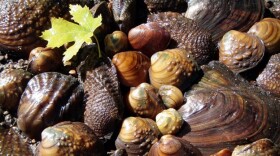As people who have heard my Field Notes before might know, I am rather fond of carnivorous plants – especially aquatic carnivorous plants. Animals are full of nutritious nitrogen and phosphorus and other nutrients that are hard to come by in the nutrient-poor environment where carnivorous plants often live. Carnivorous plants capture animals, and, after the trapped animals die, the animals rot and their nutrients are absorbed by the plants. Venus fly traps are perhaps the most famous carnivorous plants but are restricted to North and South Carolina. While pitcher plants and sundews are the darlings of Wisconsin’s carnivorous plants, we also have eight species of carnivorous bladderworts that live underwater. Bladderworts mostly capture zooplankton, tiny invertebrates that swim and feed in the water close to the plants.
But this is a story about an underwater carnivorous plant that is not a bladderwort. This rather adorable aquatic plant is called a water wheel and it has what look like a tiny Venus fly-traps at the tips of its delicate leaves, growing in whorls along its stem – all underwater. Like our native bladderworts, the traps on the lacy leaves of the water wheel capture tiny aquatic invertebrates, such as the Daphnia swimming around the plant.
This attractive plant is not found in Wisconsin, and until the last few decades, was not found anywhere in North America. It is native to Australia, Asia, Africa and Europe, but it is extinct in many of those original locations due to habitat destruction. It is now on the Global watch list of endangered plants. In the 1970s, a water wheel enthusiast was worried about the plant’s imminent extinction and tried to cultivate the plants in little tubs, but he just wasn’t having any success. So, he released them (GASP!) into some Virginia wetlands and ponds to see if he could get them to grow. They flourished in Virginia and were becoming well established. In the 1990s, another enthusiast decided to bring them to New Jersey and New York and distributed them among ponds he thought were isolated enough to avoid escape. HA! Where have we heard that before? But the little plants did not do well in any of the ponds - except one - where it was growing well in a nasty little drainage pool behind a shopping mall. In 2009, he was called out for his irresponsible actions, but he defended himself by saying he was afraid it would go extinct, and it was worth the risk.
So here is the question. This adorable little plant is not only doing well in New York, it is flourishing. In fact, it can almost be considered invasive in the small corner of New York where it is found. Should it be eliminated, if possible? Remember it is near extinction in its home range. It is most certainly exotic, but so are lilacs and daffodils, and we know that not all exotic plants become a problem.
But plenty of plants and animals that start off as innocent introductions do become invasive. Is the fact that it is endangered in its native home an excuse to allow it to grow, or should every attempt be made to wipe it out in North America? I heard about this waterwheel from an article in the New York Times two years ago, and they note that other species that were rare and endangered in their native habitat became disastrously invasive once introduced to North America. These include the Burmese Python, now rare in its native Southeast Asia but gobbling up every animal it can find in the Everglades. Sea lampreys were overfished and becoming rare in southwest Europe. They now create havoc in the Great Lakes, where they have caused the collapse of some fisheries, and managers of the Great Lakes have no choice but to spend huge amounts of money every year on pesticides targeting the lampreys.
So, introductions of species to North America that were rare in their home territories do not have a great track record. What questions should we be asking? Is the waterwheel spreading in Virginia and New Jersey? Are there signs other aquatics growing in the same waters are suffering declines? Or maybe we shouldn’t ask these questions – maybe we should eradicate it while we have the chance. Is it because it is so darn cute that we haven’t done that yet? As one scientist said of the waterwheels he found in New York, “It’s either site zero for saving a species or site zero for a really big problem.”
Stay tuned for more updates on this dicey problem.









